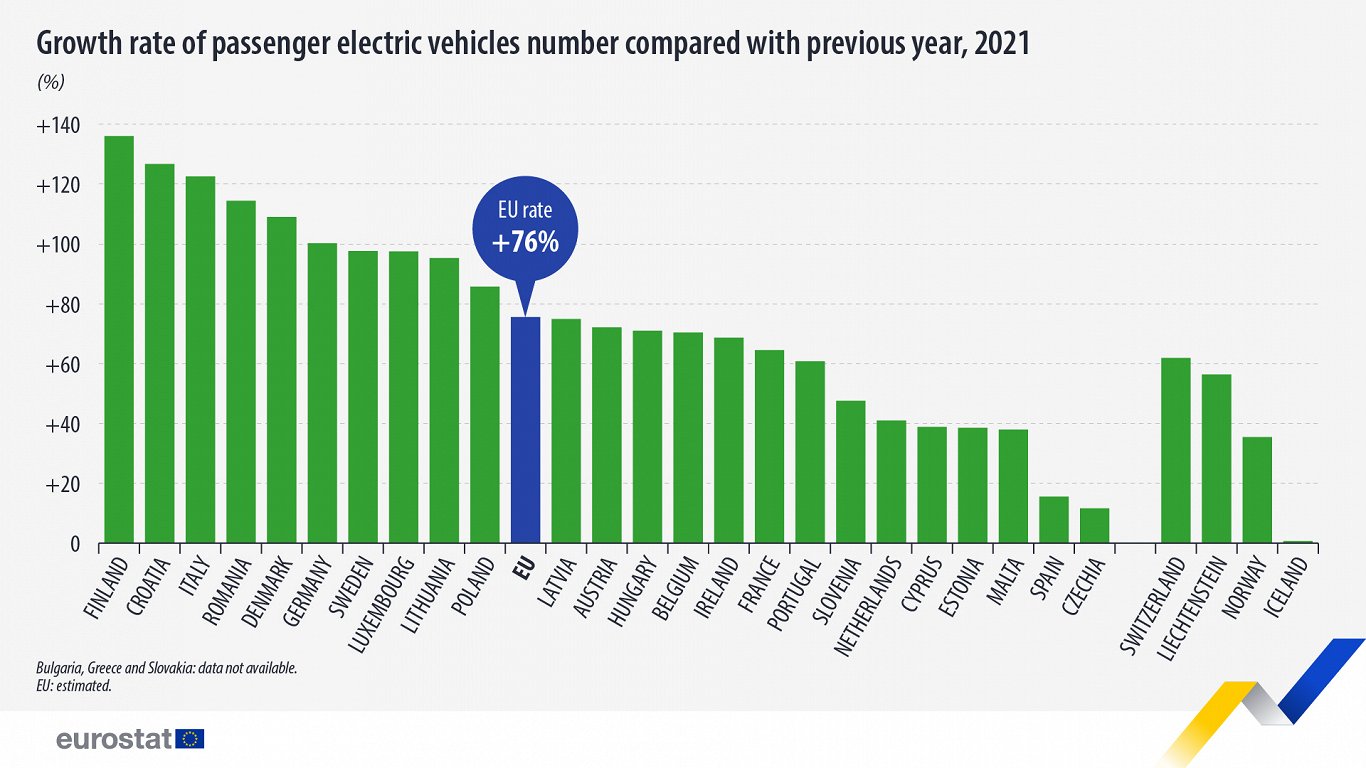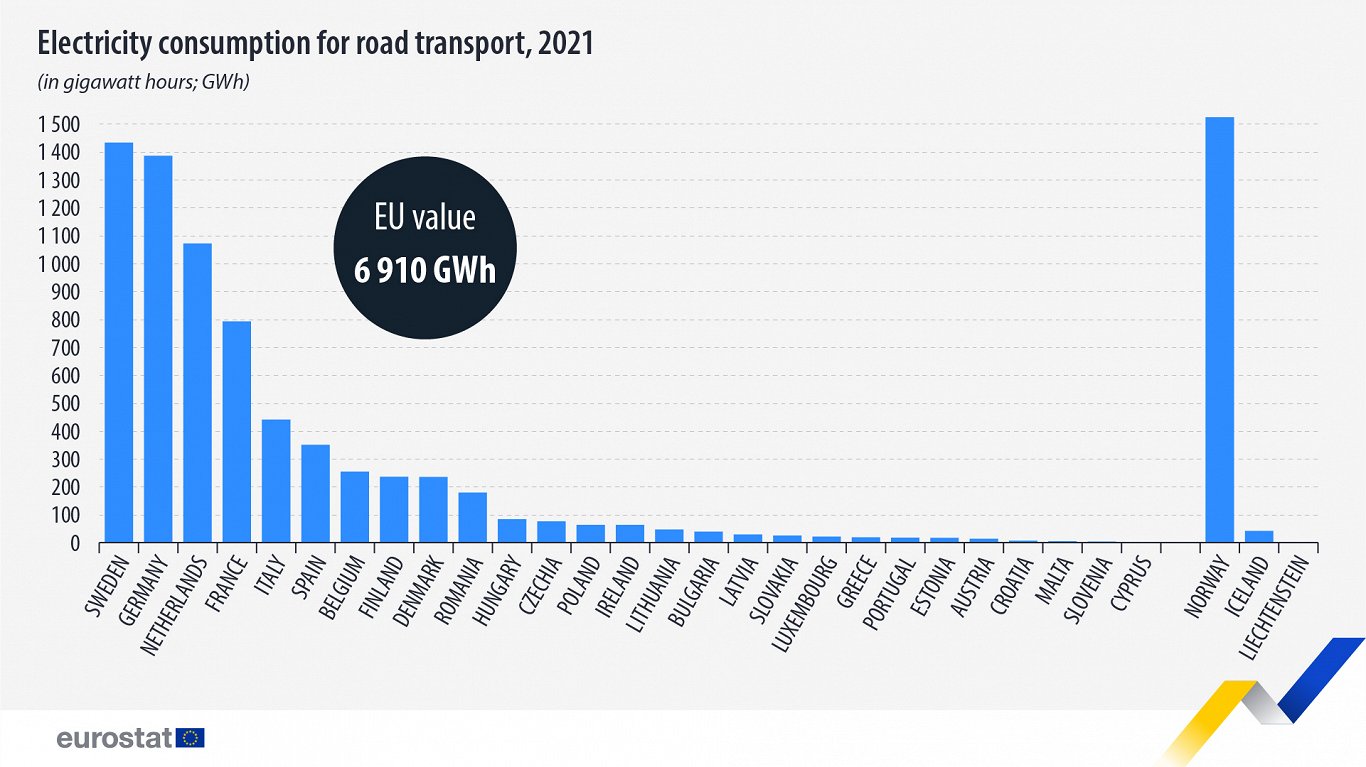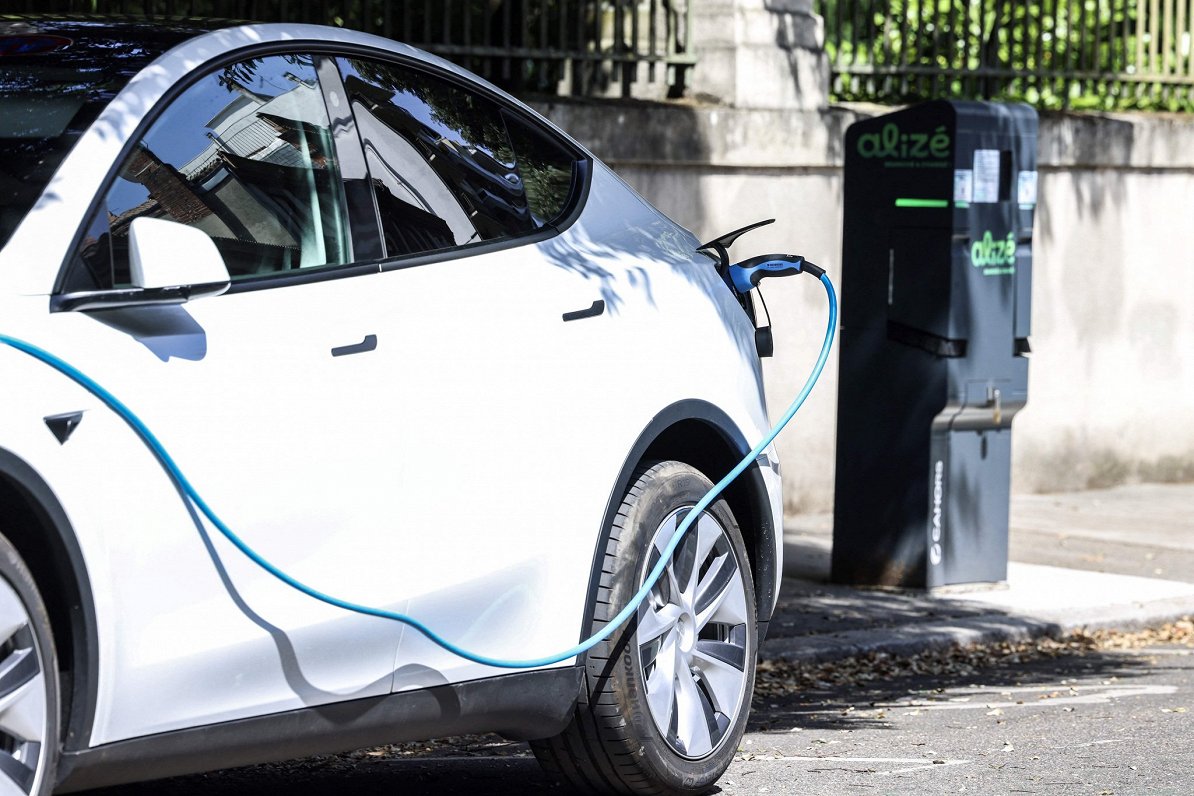Latvia’s charging network has almost two and a half stations for every ten electric cars. Estonia has one station for every 20 cars, and Lithuania has one for every ten.
This assessment is made by Ansis Valdovskis, head of Latvenergo’s Electric Vehicle Charging Network: "The charging station network in Latvia provides 2.38 stations for every 10 electric vehicles registered, while in Estonia, it is 0.57, and in Lithuania, 0.93."
Marking significant progress in the popularity of electric vehicles in Europe, the European Automobile Manufacturers’ Association (ACEA) reports that in June 2023, electric cars accounted for 15.1% of the European car market, compared to 13.4% for diesel cars. This means a historic moment for the EU, as electrics in the bloc overtake diesel cars. Petrol cars accounted for 36.3% of the total European market in June, while hybrids were at 24.3%.
New players coming on the market
According to Dainis Tropiņš, founder of SIA ‘Etago network’, an electric vehicle charging solutions provider, in terms of electric mobility, the Baltics, especially Latvia and Lithuania, are actively expanding their public charging infrastructure, and the sales of electric cars are also on the rise. Compared to the rest of Europe, we are neither leaders nor laggards.
The pace of this expansion is in line with economic processes and the financial means available to the public. This is mostly the case in the individual owners segment, but companies are also working to adapt 100% electric vehicles to the everyday operations of their fleets. These primarily include the Latvian offices of international companies that have adopted a green focus on a global scale, such as the DHL and DPD courier services, as well as local companies that have looked at the pros and cons of internal combustion engines and electric motors and opted for electric cars based on financial considerations.
Tropiņš reported rapid growth in public charging infrastructure, stating that it is a good development.
"Infrastructure needs to move forward. The public charging infrastructure we already have is good enough for the current number of electric cars; it is growing every day and will continue to do so. New players are cropping up, such as the Virši fuel stations and Enefit, while the Ignitis Lithuanian energy company is about to join the market. Other companies are making plans to build an energy charging network.
"Finally, the key players in Latvia are e-mobi and Elektrum, and they are expanding their networks; Elektrum has been particularly active over the past year, opening new charging stations, with plans to launch more of them in the future as well. Given how active the existing and new players are on the market, it is very likely that the public charging network will grow to 2000-3000 charging stations in the foreseeable future."
It should be noted that Latvenergo has set up a new brand, Elektrum Drive, as part of which it has installed the highest number of charging ports in Latvia over the past year. According to Valdovskis, the solutions used in the charging network developed by Elektrum Drive in Latvia are selected on a station-by-station basis, meaning that the equipment they select is not necessarily the most powerful, but is the most suitable for the specific location and its needs.
The charging network has units with power ranging from 22 kW to what will soon be as high as 300 kW and more in DC units with power balancing features throughout Latvia. Valdovskis reported that people can already travel reliably and risk-free in an electric vehicle around Latvia, and can even travel further to its neighbors.

Latvenergo also plans to use European assistance to build 35 more high-capacity charging stations on motorways and in Latvia’s cities within the coming two years, with the capacity to charge cargo vehicles as well.
Finally, Valdovskis pointed out that the company is working not only in Latvia, but also in Estonia and Lithuania, with the number of charging stations potentially soon reaching 500. Valdovskis expressed his satisfaction with how active the private sector has been and the confidence it has shown in the benefits of electric vehicles: "More support for businesses, as well as a clear and transparent tax policy, will certainly and significantly boost the interest of legal entities in switching their fleets to electric vehicles."
Old apartment buildings: a challenge
According to some experts, the biggest challenge for the coming years is to provide the existing apartment buildings with electric vehicle charging infrastructure. Most of the difficulties come from bureaucratic obstacles to getting land for it if the courtyard is owned by the municipality or is in shared ownership. In order to deal with this, you need to write a request and get approvals for the plan.
The process itself is long and complex, so it is often not even started or completed. It is much easier if there is an underground car park. The most popular and convenient solution, according to Tropiņš, is to simply install a cable leading to the meter in the user’s flat, or to set up a separate connection.
"In new apartment or detached-house neighbourhoods, developers already provide charging infrastructure for electric vehicles. There will be no problems charging electric cars," Tropiņš said.
"Owners of detached houses who are actively installing solar panels also set up private charging stations for their electric vehicles. There is a wide range of options in this segment, and electric car owners are taking advantage of this, because charging at home is always cheaper, meaning that driving an electric car becomes even more economical."
According to Tropiņš, there is no need to worry about power supply interruptions when using a charging station at home. Modern gear is capable of smart charging power management. For example, in a house with a maximum capacity of 11 kW, this amount of power is only delivered to the electric car when all the electric devices in the house are switched off.
"People usually charge their electric cars at night when they are asleep and other electrical devices are used little or not at all. For example, if you turn on a 2 kW electric kettle in the morning to boil water for coffee, the charging station will automatically switch to a maximum output of 9 kW/h. This means that the total connection capacity of 11 kW is never exceeded," Tropiņš explained.
Electrification rates expected to decrease
At the same time, Tropiņš pointed out that the rate of electrification in the individually-owned vehicle segment is likely to slow down in the near future. Those who have worked out the economic effect of using an electric car and can afford it have, for the most part, already made their choice.
An electric car is a very expensive purchase and for most people in Latvia, Estonia, and Lithuania, it is still something they can only dream of. Māris Jansons, head of Škoda importer Auto 100 in Latvia, confirmed this:
"There is no denying that electric cars are an expensive purchase. Today, you need 40-50 thousand euros to buy a comfortable and versatile electric family car. That’s an impressive sum. Naturally, for people living in Rīga, its suburbs, and some of the larger towns this has been an amount they could potentially manage, but it is still impossible for most people in our region. We can see this clearly in Estonia, where even with a subsidy program similar to those in place in Latvia and Lithuania, the popularity of electric cars with the public has not been significant, compared to the other two countries."
Therefore, according to Jansons, there is an urgent need for new electric cars with prices starting at 20-25 thousand euros. New electric models like this are expected to come in the foreseeable future, but they are still some years away. In addition, there is a need for national and local governments to take a much more active approach to transitioning their fleets towards environmentally-friendly vehicles.
"‘This will serve as a good example for the general public, and it is public transport that has the biggest CO2 footprint," Jansons said.

Poor supply of used cars
Used electric vehicles still cannot work as a solution for increasing the popularity of electrics. "Used electric cars on the market are still relatively new, and there is not enough variety of them. With used electrics, we’re talking about a 5 to 10 year age range. As a result, these electric cars still come at a very high price. In addition, it should be kept in mind that once an electric car is, for example, ten years old, the battery degrades enough to have lost 1/3 of its designed range per charge. So it is not economical to buy, for example, a second-hand Nissan Leaf, BMW i3, or Volkswagen e-Up! that only lasts 60-80 kilometres on a full charge. This sounds laughably low if you know that recent models of electric cars can get you 400 kilometres or, lately, even more than 500 kilometres on a single charge.
"This leaves us having to wait for new vehicles to come out. As supply increases, there will be more competition among manufacturers, which will definitely play in the favour of potential buyers. In the long run, it will certainly create more variety and better quality of used electric cars," Dainis Tropiņš said.
Compared to conventional internal combustion cars, 100% electric cars have many advantages, including reduced maintenance costs. However, in the long run, there are also various risks that are not yet relevant, but could arise once the share of electric cars is not 6% or 10%, but, say, 20% of the market or more.
Electromagnetic fields created by electric cars – what impact do they have on people’s health? Are they something to worry about? Will the design loads of public streets and roads be sufficient, because as is well-known, electric cars are significantly heavier than conventional petrol or diesel cars of identical size, due to their bulky batteries and other components? Also, as the share of electric cars increases, there is more potential for them to be involved in various road accidents, with some experts raising concern about the fire safety of electric cars.
Finally, there is a lot of uncertainty about the value of electric cars on the secondhand market. The heaviest and most expensive part of an electric car is its battery. How much will an electric car used for 10 or 15 years be worth if its battery reaches the point where it is more feasible to replace it with a new one, and the price of a new battery can be thousands or even tens of thousands of euros?
Number of recharging points in Baltic states
Estonia Latvia Lithuania
2020 183 265 126
2021 192 359 127
2022 274 499 418
2023 (YTD) 311 532 1,018
This feature first appeared in the magazine of the German-Baltic Chamber of Commerce in Estonia, Latvia and Lithuania, and is reproduced by kind permission. You can find out more about the Baltic Business Quarterly magazine here: https://www.ahk-balt.org/lv/publikacijas/zurnals.































